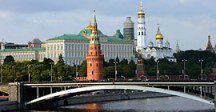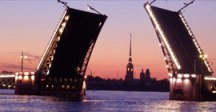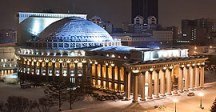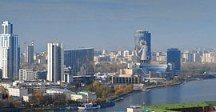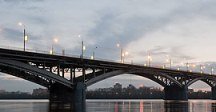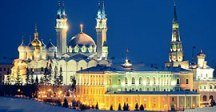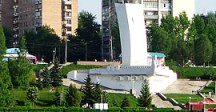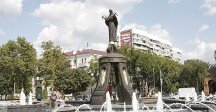Map of Kaluga
Detailed interactive map of Kaluga. Map of Kaluga with streets and numbers of houses. Satellite map of Kaluga with sights of the city.
The change between the satellite map of Kaluga and the schematic one is made in the lower left corner of the interactive map.
Kaluga
Kaluga city population: 331,842 people (2021)
Kaluga city phone code: +7 4842
Kaluga city car code: 40
Kaluga was founded in 1371.
Postal code of the city Kaluga: 248xxx
Kaluga is a Russian city located on the Central Russian upland, on the coast of the Oka. Kaluga became famous throughout Russia and the USSR for the fact that this city was the place of residence of one of the most famous scientists in the field of cosmonautics – Konstantin Tsiolkovsky.
It is with the life and work of this man that the most interesting places in the city and its attractions are connected. For example, the Museum of the History of Cosmonautics named after Tsiolkovsky, which is the largest Russian museum telling about space.
What to see in Kaluga
At the intersection of Moskovskaya Street with Kirov Street there is a beautiful church of the Beheading of the Head of St. John the Baptist. The church was built in 1735 in the Baroque style, but was later damaged in a fire in 1754, after which restoration work was carried out and new side altars were added.
Monument to Konstantin Tsiolkovsky. The beginning of Kirov Street is formed by Mira Square, in the center of which there is a monument to the most famous citizen of Kaluga, Konstantin Tsiolkovsky. The monument was opened in 1958 to mark the 100th anniversary of the scientist's birth. It depicts Tsiolkovsky in bronze, confidently striding forward on top of a granite pedestal. There is an 18-meter stainless steel rocket behind the statue.
The Myrrh-Bearing Church was built between 1798 and 1804 and consists of a rotunda topped by a dome attached through the vestibule to a three-tiered bell tower. The bell tower was built between 1818 and 1842 and also has a round shape.
Nurses Square. Right in front of the Myrrh-Bearing Church there is a small Square of Nurses, in which there is a monument dedicated to the courage of nurses of the Second World War. There are also several benches and a fountain in the park.
Monument to Sergei Kirov. Although the statue of Sergei Kirov stands on the street that bears his name since 1947, this statue is the second of its kind and was unveiled in 1977. The cast-iron statue depicts a revolutionary holding his coat and standing on a marble pedestal.
The Church of Saints Cosmas and Damian was built in 1794 in the Baroque style by the famous architect Francesco Bartolomeo Rastrelli. Its shape is unusual in that the main body of the church is crowned with five elongated multi-tiered tolobates, each of which has a small black dome. A four-tiered bell tower, built in 1797, adjoins it.
Theatre Square and Theatre Boulevard. About halfway down Kirova Street is the Theater Square, where the Kaluga Regional Drama Theater stands among fountains and trees. On the other side of Kirov Street is Teatralny Boulevard, which is a pedestrian zone that includes the first quarter of Teatralnaya Street. Here you will find many cafes and souvenir shops, as well as several sculptures, including one depicting a man similar to Konstantin Tsiolkovsky looking into space.
Victory Monument and Eternal Flame. The end of Kirov Street is marked by Victory Square. In the center of the square there is a Victory Monument consisting of a 30-meter obelisk, which was installed in 1966 on the 25th anniversary of the liberation of Kaluga. In 1970, the Eternal Flame was added, and in 1975, the obelisk was crowned with a new monument depicting Mother Russia holding a ribbon symbolizing the Oka River in one hand and a satellite in the other.
Golden Alley on Karl Marx Street. A boulevard known as Golden Alley runs between Berezuisky Ravine and Marx Street - a favorite place for locals to walk. It was here that the Kaluga Kremlin once stood. In addition to the Monument to Pushkin and the Monument to Victims of Political Repression on the boulevard itself, there are several ancient buildings nearby, including an 18th-century State Institution, a 19th-century Noble Assembly and the Governor's House.
The Intercession Church was built on the edge of the Berezuisky Ravine in about 1687 to replace an older wooden version. It is a building in the Moscow Baroque style with an elaborately decorated cubic building topped with five black domes. The bell tower was attached to the main body of the church in the 18th century.
The Kaluga Region Art Museum was opened in 1918 in the house of a local doctor, Nikanor Vasiliev, who left his art collection to the city.
Korobov's chambers. The house, known as the Korobov Chambers, got its name from its owner, who was a merchant, and has the honor of being the oldest house in Kaluga, built in 1697. The small red and white building is a perfect example of what is known as Moscow's Naryshkin Baroque. Today it serves as the exhibition center of the Kaluga Regional Museum of Local Lore.
Makarov's chambers on Pushkin Street. Next to the Kaluga Regional Museum there is a building known as the Makarov Chambers, built in 1728. Like the Korobov Chambers, the Makarov Chambers are named after their previous owner. Today, the building is still used for its original purpose - for living, which makes it the oldest residential building in Kaluga.
The Regional Museum of Local Lore of the Kaluga Region was founded in 1897 and since 1992 has been located on the territory of the former city estate of the Zolotarev family. The estate dates back to the early 19th century and includes a mansion, a large courtyard and several auxiliary buildings.
Currently, the museum hosts exhibitions dedicated to the history of the Kaluga lands, starting from ancient history up to the Russian Revolution and the Second World War. There are also expositions dedicated to the nature of the Kaluga region.
Stone bridge over the Berezuisky ravine. One of the most famous sights of Kaluga is the Stone Bridge connecting Pushkin Street with Bazhenov Street across the Berezuisky ravine. Surprisingly, this Roman-style viaduct was first opened in 1777. The bridge is almost 160 meters wide, 20 meters high and consists of 15 large arches. It is the largest stone viaduct in Russia.
Voskresenskaya Street. One of the most beautiful streets in Kaluga is Voskresenskaya Street, many of its 19th-century buildings have been preserved. This street was once the residence of the Kaluga elite, including nobles and wealthy merchants. Also on the street there is a monument to the aristocratic revolutionary Sofia Perovskaya and the church of St. George, which dates back to 1700, but is now in a rather dilapidated condition.
Monument to the 600th anniversary of Kaluga. In 1971, Kaluga celebrated its 600th anniversary, and to commemorate this, a new monument was unveiled at the entrance to the city from the bridge over the Oka River. It consists of a 50-meter obelisk with a sculpture of an astronaut, which stands next to a giant sphere in honor of the fact that Kaluga is called the cradle of cosmonautics. There are also bas-reliefs by Konstantin Tsiolkovsky and significant events in the history of the city.
Konstantin Tsiolkovsky House Museum. The house where Konstantin Tsiolkovsky lived for 29 years and where he wrote many of his most important scientific works is now a house museum dedicated to him and a memorial branch of the Museum of Cosmonautics.
Tsiolkovsky died in 1935, and the museum was opened a year later, in 1936. Although the museum was damaged during the Nazi occupation, the interior of the building has been restored to the way it looked when Tsiolkovsky lived there, and his real things are displayed in it.
Tsiolkovsky Park was built in the 18th century, and linden trees grow here, which are more than 200 years old. It was Tsiolkovsky's favorite walking place, and in 1935, after the death of the great scientist, it was unanimously decided to bury him in the park and rename it in his honor. Later, a 12.5-meter obelisk was erected over the grave where Tsiolkovsky was buried.
The Cosmonautics Museum, or the Konstantin Tsiolkovsky State Museum of the History of Cosmonautics, is the most famous attraction in Kaluga. It was decided to build a museum in Kaluga at the insistence of Sergei Korolev in recognition of Konstantin Tsiolkovsky's contribution to the Soviet Space race. In 1961, Yuri Gagarin laid the cornerstone of the building, and the museum was officially opened in 1967.
Transport in Kaluga
Kaluga-1 railway station is located in the north of the city quite far from the center, but many buses and trolleybuses connect it with the center. Kaluga Bus Station is located next to the railway station. The address of the station: Lenin Street, 10.
Popular destinations: Moscow, St. Petersburg and Tula. Suburban trains run in the direction of Moscow, Sukhinichi, Aleksin and Vyazma.
Kaluga-2 Railway Station is the second and smaller railway station in Kaluga, located about 10 km from the city. The station provides services mainly for transit trains. Trains usually stop at Kaluga-2 railway station for no more than 5 minutes. Kaluga-2 Train Station can be reached by buses No. 20 and No. 30.
Popular destinations: from Moscow to Chisinau, Kiev, Bryansk, Lviv and Odessa, as well as from St. Petersburg to Bryansk.
Kaluga Bus Station is located in the immediate vicinity of Kaluga-1 railway station in the north of the city at the beginning of Lenin Street.
Kaluga is not so far from Moscow and has good transport links to the capital, which makes it quite easy to visit. Kaluga is a good base for visiting other places in the Kaluga region, such as Kozelsk, Borovsk, Maloyaroslavets and Tarusa.
Sights of Kaluga
K.E.Tsiolkovsky House Museum, Church of Cosmas and Damian, Monument to young Yuri Gagarin, Central Park of Culture and Recreation, Planetarium, Sculpture "Bag of Happiness", Chizhevsky Museum, Church of the Intercession of the Blessed Virgin Mary "on the Moat", Chambers of Korobov Merchants, Kaluga Regional Art Museum, Gostiny Dvor, Museum of Crafts, Architecture and The State Museum of the History of Cosmonautics named after K. E. Tsiolkovsky, the House of the Noble Assembly, the Kaluga Puppet Theater, the Trinity Cathedral, the Lavrentiev Monastery.
The largest cities in Russia:
2024 © Russia-Karta.ru
